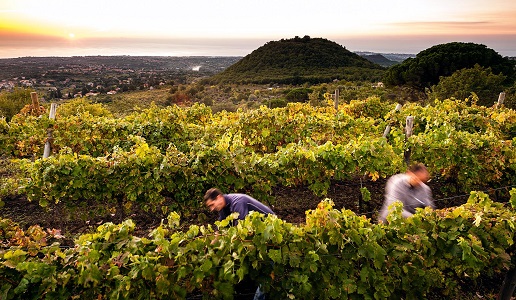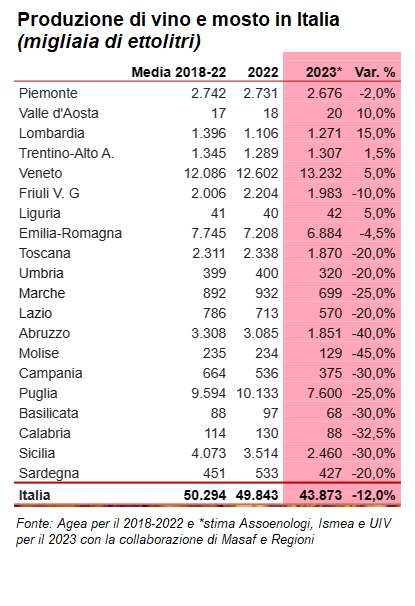Harvest forecast 2023: less then 44 million hectoliters

Italian wine production falls just under 44 million hectoliters, down 12 percent from last year's 50 million. According to forecasts by the Assoenologi Observatory, Ismea and the Italian Wine Union (Uiv), presented today at Masaf, that of 2023 could turn out to be the lightest grape harvest in the last 6 years, once again characterized by the now chronic effects of climate change, which, with its uncertain and often extreme weather patterns (+70% rainy days over the first 8 months of last year), have led to important quantitative differences across the Boot.
It is in fact a vineyard Italy split in half that photographed by the Observatory, which sees the North confirming last year's levels (+0.8%), while in the Center, South and Islands there are declines of around 20% and 30% respectively. The protagonist of the year was Downy mildew, a fungal disease caused by frequent rains that did not leave many vineyards, especially in the Center-South, with no chance. However, the Observatory technicians reiterate how Downy mildew does not directly affect the quality of healthy grapes, the first bunches harvested destined for sparkling wine bases in fact present good levels of acidity and interesting aromatic frameworks, which give positive oenological prospects. For the other types, weather conditions in September and October when the bulk of the harvest will take place will be decisive.
The overall volume contraction would mean ceding the world production lead to France, whose production is estimated at around 45 million hectoliters at -2 percent over 2022. A "pure statistic," the Observatory points out, which could prove to be more or less incisive depending on weather patterns in the coming weeks, which are crucial for bringing grapes of the later varieties in particular to optimal ripeness.
For Assoenologi President Riccardo Cotarella: "It is a very complex harvest that we are facing, characterized above all by the effects of climate change, which in late spring and early summer caused pathogenic diseases such as Downy mildew, floods, hailstorms and drought. The picture emerging from the harvest forecasts shows us a rather significant drop in grape production, especially where vines have been repeatedly attacked by the disease. On the quality front, the discourse is more complex. From the 2023 grape harvest we will definitely get good quality wines, with peaks of excellence. Much," concluded the president of Assoenologi, "will depend on the work, starting with that of the winemakers, performed in the vineyard and in the cellar. It is precisely in such strange vintages that all technical and scientific knowledge must be brought to bear to mitigate the damage of an increasingly crazy climate."
"This year's production contraction should not be an element of concern, given the high level of stocks, which exceeded 49 million hectoliters, positioning itself as the highest figure in the last six years," commented Ismea Extraordinary Commissioner Livio Proietti. The issue is not so much the loss of Italian leadership in terms of volumes produced, but rather the slowdown in domestic and foreign demand, which is depressing prices especially for table wines and IGTs. We need to work to reduce the gap in terms of value between us and France and to strengthen the competitive positioning of quality wines, making sure that even ordinary wines are increasingly characterized compared to their competitors."
For the president of Unione italiana vini Lamberto Frescobaldi: "We can no longer afford to produce 50 million hectoliters as in recent vintages, and it cannot be a fungal disease that will rebalance a situation that has recently led to the record stocks of recent years. It is surprising, in this regard, how many are still concerned about remaining holders of a production scepter that no one needs anymore: now more than ever, medium- and long-term political choices in favor of quality and structural reform of the sector are required. Priorities include finally closing the sustainability decree and modernizing the Italian vineyard, which is on average old, difficult to mechanize and expensive to manage. We also need to overhaul the criteria for "windfall" authorization of new vineyards based on appellation performance, as well as reduce yields of generic wines and review the PDO and PGI system, including their market management. These are the tools to enable Italian wine to make the qualitative leap needed to address both the cyclical situation of markets and structural changes in demand and consumption habits. Finally," Frescobaldi concluded, "it will be necessary to change gears on the commercial level, starting with the simplification of the CMO Promotion and a flagship promotion capable of involving companies from the very beginning of its planning.
Speaking in more general terms about the wine sector, Sergio Marchi, of the Masaf Technical Secretariat, said that on behalf of the government there is maximum support for the sector because wine is important for GDP, both for domestic product and export, and is a symbolic brand of Italy. He then reiterated the government's stance toward labeling and the wine and health issue. The government's moves will continue to be those against counterfeiting and Italian sounding. Finally, he added that the government will sit at the table with the regions to bargain over plant diseases, which have been incidents again this year, in terms of quantity rather than quality.
 Vineyard Geography Italy 2023
Vineyard Geography Italy 2023
Although the peculiar nature of the season does not allow for homogeneous forecasts even in the same area, this year it can still be said that, even with due distinctions, the North has held up decidedly well, substantially confirming last year's levels. Going down to the Center, declines are averaging more than 20 percent, while in the South and the Islands reductions of 30 percent are close. An overall picture," cites the Observatory's report, which was also carried out with monitoring by the Ministry of Agriculture and the Regions, "in which there were some additional difficulties for organic production.
In the Northwest, there is a major recovery in Lombardy, followed by a more moderate one in Liguria and Valle d'Aosta, with Piedmont holding up substantially. The Northeast is driven by the locomotive Veneto, despite everything slightly up on last year thanks in part to the entry into production of new plants. Trentino-Alto Adige does not deviate much from last year's levels, while Friuli-Venezia Giulia and Emilia-Romagna lose a few percentage points. More homogeneous is the situation in the Center-South characterized by declines ranging from 20 to 45 percent, with harvests expected to be much more scarce especially on the Adriatic ridge (Marche, Umbria, Abruzzo, Molise, Puglia, Calabria, Basilicata) but also in Tuscany, Lazio, Campania, Sicily and Sardinia.
Climatic and vegetative trends (detail in the attached report)
Abundant and frequent spring rainfall created favorable conditions for the outbreak of vine diseases and especially Downy mildew, which did not spare many vineyards especially in south-central Italy. The continuous rains, in fact, in many cases prevented entering the vineyard to make treatments and in others thwarted their effects. Add to this other diseases such as Powdery mildew and Golden Flavescence, as well as hail and other adverse weather events during the summer, and the picture of the viticultural situation is colored in less than brilliant hues for production as a whole, but especially for organic ones.
A year with crazy weather that once again highlighted how the great professional technical potential allows companies that have relied on the technique and science of the many winemakers and viticultural technicians to achieve quality in line with the average of recent vintages.

 Italiano
Italiano







